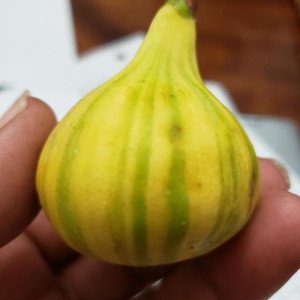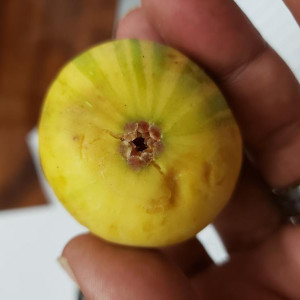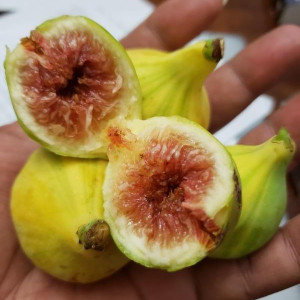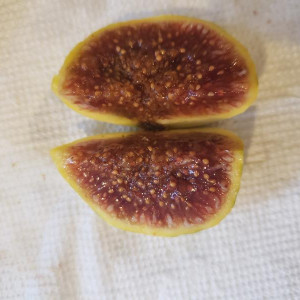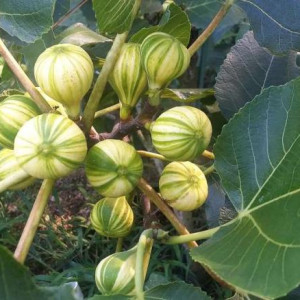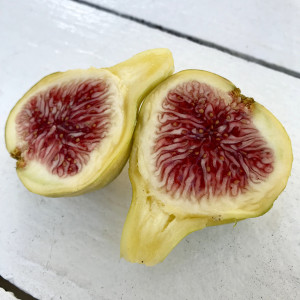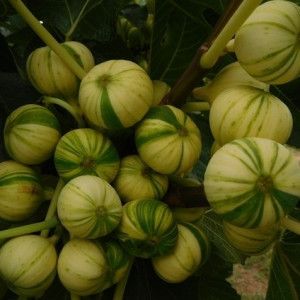This site contains affiliate links for which I may be compensated.
Panache
Panache Information
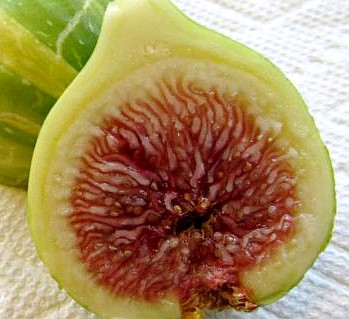

-
Possible Synonyms / AKA:
DFIC 2, Bizzarria di Sori? (Read colored notes), Bourjassotte Panachee, Bracotedesco, Calabacita, Cold: Signora Panachee, Courgetta Rayee, F. pachycarpa var. fasciata Gasparrini, Ficus carica radiata Risso, Figa Turca, Fracazzano Rigata, Jaspee, Limone, Maravilla, Marbled Limone, Pere Hilarion, Panache, Plume, Princessa, Rayonne, Signora Panachee, Striped, Striped Bourjassotte, Striped Tiger, Tiger, Panache Tiger, Variegato, P.I. No. 86,169, PI 86169
-
Introduced By:
-
Origin:
France -
Main Flavor Group:
Adriatic - delivers a balanced sweetness with a refreshing, light flavor. It combines subtle berry-like notes. Yellow or green skin and usually red pulp, with more complex additional flavors developing when fully ripe. -
Family Group:
-
Fig Type:
Common - Self fertile and will grow anywhere conditions are suitable -
Cold Hardy:
No -
Container Variety:
N/A -
Easy Rooting:
N/A -
Main Season:
late -
Availability:
Average -
Breba Crop:
No -
Seed Crunch:
mild -
Eye:
N/A -
Skin Toughness:
N/A -
Fruit Size:
Small to medium -
Rain Resistance:
N/A -
Tree Vigor:
N/A -
External Links:
https://www.ourfigs.com/forum/figs-home/331728-panache-branch-reverted-back-to-green
https://www.ourfigs.com/forum/figs-home/632882-what-was-panache-sport-of
https://www.youtube.com/watch?v=dG4VSFePmzg
https://www.youtube.com/watch?v=m8ap3Ke8N2g
Description
"Panache" fig (Ficus carica "Panachee") has other names that allude to its Variegated appearance: "Panache," "Variegato" or "Striped Tiger." No matter what you call it there is no mistaking this pink-fleshed and yellow- and green-striped fig. This fig variety grows in U.S. Department of Agriculture plant hardiness zones 7b through 10b. The warm weather in these growing zones is needed for a fruitful "Panache" fig harvest, which only comes after a long, warm growing season.
The fruit from a "Panache" fig tree will not be ready until August. Harvest season for this fig variety lasts from August through the first week of November. This Main crop of figs is harvested and used fresh from the tree to be enjoyed for its rich, raspberry flavor.
You can find the entire "Italian Numbered Figs Found At Bay Area Scion Exchanges here"
Panache, like many other variagated figs can revert back to solid color. In this case, Panache would become Reverse. Panache is a sport of Bordissot Blanca Rimada.
Take notes... From Ben B. on his post:
Bizzarria di Sori (syn.Panascè/Panachè) -
With green and yellow striped fruits, this is truly a unique fig and worthy of the name Bizzaria. The rose colored flesh is of good flavor. Produces a Breba and a Main crop . This variety is typical of Liguria and the Côte d'Azur.
With green and yellow striped fruits, this is truly a unique fig and worthy of the name Bizzaria. The rose colored flesh is of good flavor. Produces a Breba and a Main crop . This variety is typical of Liguria and the Côte d'Azur.
Condit Monograph:
Panachée: (syns. Figa Turca, Maravilla, Princessa, Rayonne, Courgette Rayée, Jaspée, Limone, Bourjassotte Panache e, Père Hilarion, Striped, Tiger, Zigarella, Col di Signora Panachée, Variegato, Fracazzano Rigato, Bracotedesco, Ficus carica radiata Risso, Ficus pachycarpa var. fasciata Gasparrini). Described by Risso (1826), Gasparrini (1845), Audibert Frères (1854), Hogg (1866), Pasquale (1876), Barron (1869b, 1891), Soc. Pomol. DE France (1887, 1947), Eisen (1888, 1901), Sauvaigo (1889), Colby (1894), Cusin (1900), Trabut (1904), Starnes and Monroe (1907), Vallese (1909), Roeding (1914), Borg (1922), Condit (1921b, 1928b, 1947), Davis (1928), Blin (1942), and Simonet et al. (1945). Illustrated in color by Barron (1869b) and Condit (1941a). Illustrated in Black and white by Vallese, Condit (1928b, 1941a, fig. 8, D), and Simonet.
In Dendrologia Naturalis, published in 1668, Ulisse Aldrovandi described and illustrated a fig designated as “ficus virgata fructu,” or virgate fruit, marked with alternating bands of yellow and green. A translation (courtesy of Mrs. P.H. Timberlake) of an interesting speculation as to its origin follows: “Whether or not there is any truth in what Palladius stated in Martins, title 10, to wit, that the bicolored fig sprouts from two branches (the white and the dark kind) which have been twisted together and tightly bound, so that the buds are forced to mix their juices, and combine by this means the distinct peculiarities of both, it is at least not certain that they have ever grown together naturally.”
It was probably this same fig which Risso described as Ficus carica radiata, and Gasparrini as Fico Limone.
According to Condit (1928b), the origin of this sectorial chimera has not been learned. Barron (1869b) described it as a sport from the better-known Col di Signora Bianca, one of the finest Italian varieties.
Borg reported that this Variegated fig, “Tina ta Spanja,” grown at Marsascala in Malta, is said to be of Spanish origin, and needs Caprification . P.I. No. 86,169, obtained from Lérida, Spain, in 1928, has proved at Riverside to be identical with Panachée, and to belong to the Common type of figs. Individual trees are found in widely separated localities of California, but there is little if any interest in extending its culture.
The tree is moderately vigorous and upright in habit of growth; bark of young twigs commonly tawny or brown, and striped with yellow; terminal buds green. Leaves not Variegated , above medium to large, mostly 5-lobed; upper sinuses of medium depth, rather narrow, lower sinuses shallow, basal sinuses narrow, or in some almost closed; upper and basal lobes often Auricled ; margins coarsely crenate; surface dull. The following description of fruit is from specimens produced at Riverside since 1930.
Brebas none. Second-crop figs medium, up to 2-1/4 inches in length and 2 inches in diameter; average weight 40 grams; shape pyriform, with neck prominent, and somewhat flattened in some specimens; stalk to 3/8 inch long; ribs practically absent; surface glossy, with a delicate bloom; white flecks inconspicuous; eye medium or above, open, scales variable, from chaffy to light violet; color light yellow, with Alternate bands of green, the latter fading out at complete maturity; meat thick, white; pulp strawberry, mealy in texture; quality mediocre to poor. (Plates 8; 26, D.)
Caprified figs are somewhat larger, with pulp blood-red in color. Splitting of fruit bad, even when uncaprified, as shown in color illustration by Barron.
If you'd like your banner to be shown here and throughout Fig Database, send us a message.
Photos Add Your Image
YouTube Videos
No Videos Found






